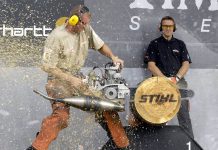Leif Yttergren
The Swedish School of Sport and Health Sciences, Stockholm

Leisure Cultures and the Making of Modern Ski Resorts
236 pages, hardcover.
London: Palgrave Macmillan 2019 (Global Culture and Sport)
ISBN 978-3-319-92024-5
Virtually all researchers who write about skiing as leisure and sport start by stating that these activities are poorly explored. This applies not only to Swedish researchers, but also to international scholars as well. The need for research is clearly great. That’s why I was delighted to receive Austrian Philipp Strobl’s and Australian Aneta Podkalicka’s anthology Leisure cultures and the making of modern ski resorts. It does not primarily treat skiing as sports or leisure activity, but focuses on the creation and development of well-known ski resorts in different parts of the world. Subject-wise, the content can be described as human geography with a (technology-) historical focus. It is exciting and commendable and should attract follow-ups even in our latitudes, even though human geography studies in Sweden are less than vigorous, at least when it comes to sports related issues.
In total, the anthology consists of nine chapters written by researchers from different parts of the world, and not only the West, which unfortunately is so often the case in the academic world, but also from slightly odd countries in this context, such as Turkey and Poland. The Polish researcher Stanislaw Jędrzejewski’s article on Polish downhill skiing and the emergence of ski resorts after The Second World War in communist and relatively poor Poland stands out, among other things, through the political context. Downhill skiing and communism sound like strange bedfellows. He notes that the development of skiing depended on political decisions more than on business considerations, which is common in the Western world. Downhill skiing and the construction of ski resorts were low priorities in the prevailing planned economy in Poland in relation to large government investments in heavy industry. It wouldn’t be until after the fall of the Wall that Polish ski enthusiasts could fully indulge in their interest. Parenthetically, in connection to state interference, it is worth mentioning that in the 1970s, the Swedish Social Democratic government under Olof Palme decided that the state should invest in the mountainous Åre region with the aim of making skiing more popular, “skiing for all” in accordance with the spirit of the times. Among other things, the state was behind the construction of the cable car, which was completed in 1976.
In the following, four chapters of the anthology will be further commented on. They have in common that they investigate and analyse the origin of an individual ski resort. It is thus the physical space of downhill skiing that is the focus of the anthology. Here, however, it should be said that the opening chapter is extremely interesting and creates a good theoretical framework around the ensuing chapters, which, to be honest, felt a little theoretically thin by comparison. Perhaps it would have been better to place parts of the opening chapter in a concluding chapter and to make the comparative aspect of the various chapters clear at the start of the book.
Austrian Christof Thöny writes about the area of Arlberg in the western part of Austria where a number of ski resorts make up the geographical unit Arlberg, including the familiar St. Anton for many Swedes. Among other things, he shows how important the creation of ski lifts was for the development of infrastructure in Arlberg, as these enabled mass tourism in a completely new way: more slopes – more tourists – more hotels/apartments – more shops – more restaurants, and so on. Ski lifts began to develop before The Second World War, but the production of more comfortable and faster lifts with greater capacity shot up after the war, and thus new ski resorts were quickly built and developed both quantitatively and qualitatively.
The unveiling was a glamorous affair with Hollywood stars, and the link between luxury, exclusivity, downhill skiing and celebrities was a given part of the marketing of Sun Valley.
Another technological innovation that was also a prerequisite for the expansion of different ski areas was the establishment of the railway. In addition to Arlberg, this was also true for Storlien and Åre in western Jämtland, and not least Sun Valley in Idaho in the US. This first major American ski resort was created with capital from railway companies and owned by them as well. Know-how came from Austria in terms of the ski resort’s infrastructure and ski school pedagogy, as Günter Beshof notes in the article with the catchy title: “American Bucks and Austrian Buccaneers: Sun Valley – The Making of America’s First Winter Resort.”
Sun Valley was thus America’s first major ski resort when it opened in the 1930s. The unveiling was a glamorous affair with Hollywood stars, and the link between luxury, exclusivity, downhill skiing and celebrities was a given part of the marketing of Sun Valley. However, it was Austrians who were responsible for everything related to skiing – their influence, know-how, was everywhere and Günter Bischof notes: “Sun Valley had become as much the St. Anton of the Rockies, as St. Anton had become the Austrian Sun Valley.”
A given component in ski resorts was the skiing schools. Downhill skiing was a difficult activity and the need for knowledge was great. Long, heavy skis made a mess of the beginners. At the skiing schools, various pedagogical and didactic methods were developed. The most renowned, by far, was the “Arlberg method” (Arlberg – the university of skiing); it had a major impact both in Europe and in the rest of the world, not least thanks to Austrian ski instructors working in different ski resorts around the world. They basically had a monopoly on the didactic part of downhill skiing. A completely new profession with registered instructors emerged, whose scope and importance is difficult to take in for the unitiated. Trained gymnastics director Sigge Bergman (“father of Swedish skiing”) also visited Arlberg for a couple of seasons and brought the Arlberg method to Sweden and to the Swedish ski schools in Jämtland. The most famous contemporary ski instructor was Hannes Schneider. He fled Nazi Austria, where he was threatened with internment, for the United States, where he quickly became an established and well-known ski instructor in the north-eastern United States using the Arlberg method as his educational tool. Today, the role of ski schools has been greatly reduced and with it the previously prestigious skiing teacher profession. Skis, boots and bindings have been improved and well-prepared slopes make it easier to ski. Even beginners can quickly learn to race with some benefit.
This reviewer would have liked a concluding chapter with comparative ambitions, which however to some extent is compensated by the exciting opening chapter.
Turkish researcher Onur Inal’s contribution “Mount Uludağ. The Making of Turkey’s St Moritz” links the emergence of a new leisure/ski culture with the country’s secularization and modernization, which gained momentum after President Atatürk’s takeover in 1924. A strong orientation towards western ideals and habits took place and this transformation included the development of a skiing culture in Mount Uludağ. The mountain is located in western Turkey, south of Istanbul. Onur Inals writes: “Mount Uludağ served as marker of upper-class liberty and provided an outlet to demonstrate not only their social difference but also their freedom and individualism.” Downhill skiing was a class marker in the 1950s and 1960s, not just in Turkey.
Timewise, the focus of the authors is on the development of ski resorts after The Second World War, when the growing middle class had an increasingly higher standard of living and longer holidays. The tourism industry expanded significantly. Before The Second World War, ski resorts in the Alps were exclusive “gated communities” for upper-class people, not infrequently from England. Thus, after the Second World War, there was a certain social broadening, a sort of reverse gentrification, although a certain social exclusivity continues to characterize many ski resorts.
Philip Stroble describes and analyses the first Australian ski resort, Thredbo Resort in the state of New South Wales. He notes that Thredbo was a result of “transnational actors” operating in Australia but also in Europe and the US at different ski resorts. As in Europe, skiing culture in Austria was the model, from the didactics of skiing schools to beer-drinking men in Lederhosen. In Thredbo’s case, Kitzbühel was a role model and what enabled the expansion of the resort was the ski lifts introduced in the late 1950s. Like other ski resorts regardless of geographical location, the following developments took place in Thredbo, which Stroble sums up well: “a space of ‘cultural hybridity’, attracting professional skiers, international media coverage, the jet-set crowd, middle-class leisure seekers as well as specialised transmigrants from all over the skiable world.”
What about Sweden? Unfortunately, no analysis is made of Åre’s development from a small spa resort at the end of the 19th century to a state-of-the-art ski resort, a white middle-class paradise in many respects. Davos in Switzerland has served as a model for Åre. There are clearly great research opportunities of a multidisciplinary nature here. Swedish scholar Daniel Svensson participates in the anthology and his article, unlike the others, does not address downhill skiing but focuses mainly on a couple of places where cross-country skiing is practiced in Sweden: Vålådalen in Jämtland and Hindås outside Gothenburg.
This reviewer would have liked a concluding chapter with comparative ambitions, which however to some extent is compensated by the exciting opening chapter. It is striking how similar the development looks in the different ski resorts despite geographical differences. There is a specific cultural environment around downhill skiing regardless of geographical locality but also structural and social similarities in terms of, among other things, technological development (lifts), transport systems (trains), skiing schools, social exclusivity. The anthology inspires further studies in the Swedish context. The development in Åre, Idre and the Sälen alps deserves to be analysed and compared.
Copyright © Leif Yttergren 2021
Table of ContentSkiing Transnational: Cultures, Practices, and Ideas on the Move
|








